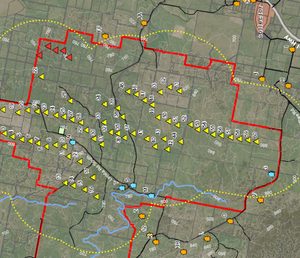Despite much gnashing of teeth among wind developers and some wind advocates, it appears that the Australian wind industry is adjusting to larger setback requirements. In the past two months, two large wind farms have cleared key approval hurdles in New South Wales, with both incorporating the 2km setback requirement from non-participating homes that is included in draft NSW wind planning guidelines.
The 33-turbine Bodangora Wind Project received approval from the NSW Planning Assessment Commission in late August, which noted that while “noise emissions from the turbines will be audible from some surrounding dwellings,” sound models suggest that sound at non-participating neighbors will be 30dBA or less (and 52dBC or less), noting that “the 2km buffer provided in this instance is highly precautionary.”
 Meanwhile, the 63-turbine Collector Wind Farm has been received a recommendation for approval by the NSW Department of Planning this week, and now awaits final approval from the Planning Assessment Commission. Despite the recommendation, Tony Hodgson of Friends of Collector said strong opposition remained in the community, which would be enthusiastically voiced at a community meeting with the PAC at the end of October. “We spent a lot of time and a lot of energy putting in our submission, and nobody from the department ever talked to us,” Mr Hodgson said. “We feel very, very hard done by. We think it’s an outrage, and the whole thing’s been a complete waste of our time.” The Collector project includes one home just inside the 2km buffer, and a couple more just outside it, as seen on the most recent site map (above; yellow line is 2km; red turbine sites have been removed). The project’s Sound Assessment found that the three closest non-participating homes would remain just under the 35dBA noise limit (10-minute average), as well being well below the 60dBC limit.
Meanwhile, the 63-turbine Collector Wind Farm has been received a recommendation for approval by the NSW Department of Planning this week, and now awaits final approval from the Planning Assessment Commission. Despite the recommendation, Tony Hodgson of Friends of Collector said strong opposition remained in the community, which would be enthusiastically voiced at a community meeting with the PAC at the end of October. “We spent a lot of time and a lot of energy putting in our submission, and nobody from the department ever talked to us,” Mr Hodgson said. “We feel very, very hard done by. We think it’s an outrage, and the whole thing’s been a complete waste of our time.” The Collector project includes one home just inside the 2km buffer, and a couple more just outside it, as seen on the most recent site map (above; yellow line is 2km; red turbine sites have been removed). The project’s Sound Assessment found that the three closest non-participating homes would remain just under the 35dBA noise limit (10-minute average), as well being well below the 60dBC limit.
The NSW Draft Planning Guidelines, which were released in December 2011 and have yet to be finalized, included a requirement that projects receive permission from all homeowners within 2km. NSW’s southern neighbor Victoria has been operating under a 2km setback requirement for two years now; over 20 wind projects are in the planning stages, with one in the midst of the approval process. NSW’s other neighbors, South Australia and Queensland, are also charting cautionary paths, though without absolute 2km limits on the table so far (both have 35dBA noise limits, which generally requires setbacks of 1.5km or more). As in Australia, the US state of Oregon appears to have a robust wind development environment, despite the widespread use of a 36dBA noise limit, which similarly pushes turbines significantly further away from neighboring homes than is typical in much of the US and Canada.

October 15th, 2013 at 7:18 am
I clicked on several links and couldn’t find the size of each turbine, but they appear to be huge 3.6 MW turbines if there are 33 of them with a nameplate capacity totaling 120 MW.
In Vermont, we have 2.5 and 3 MW turbines and routinely receive complaints from people about audible noise and health effects from inaudible infrasound at 2.5 miles or more, which is 4 km. The people who live 1.25 miles or 2 km away are getting hammered with noise from Vestas v112 3 MW turbines.
Sorry, folks, this is a good start, but it is not protective of public health. At all. Any claims that the 2 km setback is conservative is one being made by wind proponents, not those who care about protecting public health.
And the dBA level, well unless there is continuous monitoring or some sort of enforcement, the only times those standards matter is when the wind companies’ own experts are doing sound monitoring, and they know how to game their reports, deleting inconvenient data and placing monitoring equipment in areas where there will be a lot of interference. This whole industry is doing renewable energy a tremendous disservice with its continuing denial of the harm it is causing.